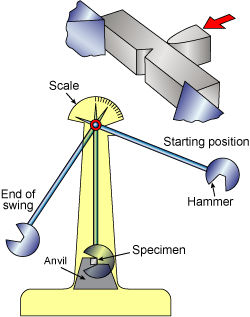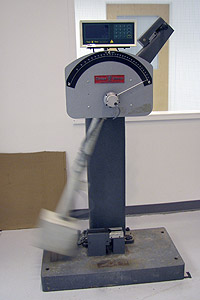Difference between revisions of "Impact Testing"
(Created page with "Category:Measuring, Calibration{{Knoppen}} <noinclude><!------------------------------------------------ * READ THIS FIRST * Only edit this page if you can improve the cont...") |
|||
| Line 7: | Line 7: | ||
* Please start editing this page after the /noinclude | * Please start editing this page after the /noinclude | ||
* -------------------------------------------------></noinclude> | * -------------------------------------------------></noinclude> | ||
[[File:Impact testing.gif|thumb|right|Impact Testing]] | |||
[[File:Impact testing1.jpg|thumb|right|Impact Testing]] | |||
'''Impact Testing''' is non destructive testing involving induced waves into structures by impact is used to evaluate the condition of building materials and to detect flaws. | |||
Sounding is the simplest form of impact testing. On delicate materials such as terra cotta, it is referred to as tapping. In addition to using a hammer, sounding can also be performed by dragging a chain or using a special rotary percussion device. Materials without problems will ping at their natural frequencies; materials with problems will thud due to flexural vibrations at lower frequencies. | |||
Although the ear is an excellent frequency analyzer, some document sounding by using a hammer with a pressure sensor and a transducer to record the impact wave. The graph of the amplitude vs. frequency is called a mobility plot. Low frequency thuds will produce a high slope, high frequency pings will produce a low slope. Other sonic differences will also appear on the plot, as compared to a plot from a region without problems. | |||
'''Impact-Echo (IE) testing''' uses different hammer weights to induce temporary standing waves between the surface and the bottom of a slab or void. In the graph of amplitude vs. frequency, these standing waves appear as peaks. Differing conditions can cause peaks to shift, or cause multiple peaks. | |||
'''Ultrasonic Pulse Velocity (UPV) testing''' is used to measure the speed of a wave through a material. Differences in the arrival time of the wave can be due to problems with the material or with embedded materials otherwise not accessible except through destructive means. | |||
'''Rebound hammer testing''' is an indication of the surface hardness of a material. A known weight is impacted against the surface at a known velocity, and the distance the weight rebounds after impact is measured. The arbitrarily scaled rebound number can be correlated to the compressive strength of concrete or to the proper mixing of mortar. | |||
Impact testing is a test designed to give information on how a specimen of a known material will respond to a suddenly applied stress, e.g. shock. The test ascertains whether the material is tough or brittle. | |||
A test of the impact strength of a material, used to determine its relative | |||
ductility or brittleness. The test is executed by swinging a large, heavy | |||
hammer on a pendulum from a predetermined height. The hammer fractures the material sample, usually a block of a certain size with a notch cut in it. The height to which the pendulum swings is used to calculate the | |||
energy necessary to fracture the sample. | |||
Latest revision as of 09:14, 4 January 2013
Impact Testing is non destructive testing involving induced waves into structures by impact is used to evaluate the condition of building materials and to detect flaws.
Sounding is the simplest form of impact testing. On delicate materials such as terra cotta, it is referred to as tapping. In addition to using a hammer, sounding can also be performed by dragging a chain or using a special rotary percussion device. Materials without problems will ping at their natural frequencies; materials with problems will thud due to flexural vibrations at lower frequencies.
Although the ear is an excellent frequency analyzer, some document sounding by using a hammer with a pressure sensor and a transducer to record the impact wave. The graph of the amplitude vs. frequency is called a mobility plot. Low frequency thuds will produce a high slope, high frequency pings will produce a low slope. Other sonic differences will also appear on the plot, as compared to a plot from a region without problems.
Impact-Echo (IE) testing uses different hammer weights to induce temporary standing waves between the surface and the bottom of a slab or void. In the graph of amplitude vs. frequency, these standing waves appear as peaks. Differing conditions can cause peaks to shift, or cause multiple peaks.
Ultrasonic Pulse Velocity (UPV) testing is used to measure the speed of a wave through a material. Differences in the arrival time of the wave can be due to problems with the material or with embedded materials otherwise not accessible except through destructive means.
Rebound hammer testing is an indication of the surface hardness of a material. A known weight is impacted against the surface at a known velocity, and the distance the weight rebounds after impact is measured. The arbitrarily scaled rebound number can be correlated to the compressive strength of concrete or to the proper mixing of mortar.
Impact testing is a test designed to give information on how a specimen of a known material will respond to a suddenly applied stress, e.g. shock. The test ascertains whether the material is tough or brittle.
A test of the impact strength of a material, used to determine its relative ductility or brittleness. The test is executed by swinging a large, heavy hammer on a pendulum from a predetermined height. The hammer fractures the material sample, usually a block of a certain size with a notch cut in it. The height to which the pendulum swings is used to calculate the energy necessary to fracture the sample.

